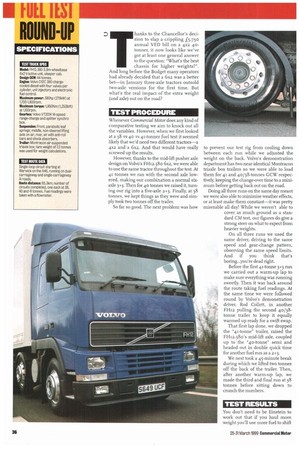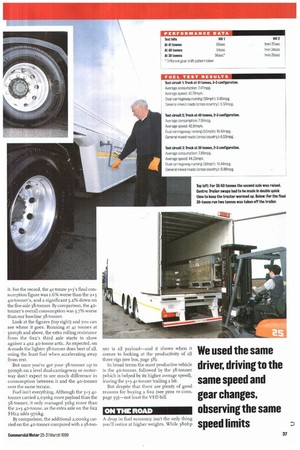hanks to the Chancellor's decision to slap a crippling i5,750
Page 38

Page 39

Page 40

If you've noticed an error in this article please click here to report it so we can fix it.
annual VED bill on a 4x2 40tonner, it now looks like we've got at least one general answer to the question: "What's the best chassis for higher weights?".
And long before the Budget many operators had already decided that a 6x2 was a better bet—in January three-axle tractors outsold two-axle versions for the first time. But what's the real impact of the extra weight (and axle) out on the road?
TEST PROCEDURE
Whenever Commercial Motor does any kind of comparative testing we aim to knock out all the variables. However, when we first looked at a 38 vs 40 vs 41-tonner fuel test it seemed likely that we'd need two different tractors—a 4x2 and a 6x2. And that would have really screwed up the results.
However, thanks to the mid-lift pusher axle design on Volvo's FH12.38o 6x2, we were able to use the same tractor throughout the test. At 41 tonnes we ran with the second axle lowered, making our combination a normal sixaxle 3+3. Then for 40 tonnes we raised it, turning our rig into a five-axle 2+3. Finally, at 38 tonnes, we kept things as they were and simply took two tonnes off the trailer.
So far so good. The next problem was how
to prevent our test rig from cooling down between each run while we adjusted the weight on the back. Volvo's demonstration department has two near-identical Montracon triaxle box trailers SO We were able to load them for 41 and 40/38-tonnes GCW respectively, keeping the change-over time to a minimum before getting back out on the road.
Doing all three runs on the same day meant we were also able to minimise weather effects, or at least make them constant—it was pretty miserable all day! While we weren't able to
cover as much ground as a standard CM test, our figures do give a strong steer on what to expect from heavier weights.
On all three runs we used the same driver, driving to the same speed and gear-change pattern, observing the same speed limits. And if you think that's boring...you're dead right.
Before the first 41-tonne 3+3 run we carried out a warm-up lap to make sure everything was running sweetly. Then it was back around the route taking fuel readings. At '1 the same time we were followed round by Volvo's demonstration driver, Rod Collett, in another FHI2 pulling the second 40/38, tonne trailer to keep it equally warmed up ready for a swift swap.
That first lap done, we dropped the "41-tonne" trailer, raised the Fli12.38o's mid-lift axle, coupled up to the "4o-tonne" semi and headed out in double quick time for another fuel run as a 2+3.
We next took a 45-minute break during which we lifted two tonnes off the back of the trailer. Then, after another warm-up lap, we made the third and final run at 38 tonnes before sitting down to crunch the numbers.
TEST RESULTS
You don't need to be Einstein to work out that if you haul more weight you'll use more fuel to shift it. For the record, the 41-tonne 3+3's final consumption figure was 1.6% worse than the 2+3 4o-tonner's, and a significant 5.2% down on the five-axle 38-tonner. By comparison, the 40tonner's overall consumption was 3.7% worse than our baseline 38-tonner.
Look at the figures (top right) and you can see where it goes. Running at 41 tonnes at 5omph and above, the extra rolling resistance from the 6x2's third axle starts to show against a 4x2 40-tonne artic. As expected, on A-roads the lighter 38-tonner does best of all, using the least fuel when accelerating away from rest.
But once you've got your 38-tonner up to 50mph on a level dual-carriageway or motorway don't expect to see much difference in consumption between it and the 4o-tonner over the same terrain.
Fuel isn't everything. Although the 3+3 41. tonner carried 2,030kg more payload than the 38-toiler, it only managed 30kg more than the 2+3 4o-tonne, as the extra axle on the 6x2 FHI2 adds 970k8.
By comparison, the additional 2,000kg carried on the 4o.tonner compared with a 38-ton
ner is all payload—and it shows when it comes to looking at the productivity of all three rigs (see box, page 38).
In broad terms the most productive vehicle is the 4o-tonner, followed by the 38-tonner (which is helped by its higher average speed), leaving the 3+3 4I-tonner trailing a bit.
But despite that there are plenty of good reasons for buying a 6x2 (see pros vs cons, page 39)—not least the VED bill.
ON THE ROAD
A drop in fuel economy isn't the only thing you'll notice at higher weights. While 38ohp will comfortably deliver the goods at either 40 or 41 tonnes, driving our FI-112-38o we generally needed to hold a gear for another toorpm or so (to around 1,700rpm) before changing up, if we wanted keep up a decent pace at the heavier weights and ensure the rev needle dropped back to peak torque at i,toorpm.
That's hardly a chore, especially if, like ours, your FH12, has the slick new Volvo VT synchro box. But it does alter driveability—on average you're half a gear down on the 38-tonner. While more weight on the trailer holds you back more on the hills, as our climb times show, we're really only talking seconds. If you're desperate for more performance, spec more horses.
Then there's ride stability. The 6x2's extra axle ensures it handles better, with less cab roll than the two-axle 4o-tonne artic. And that extra axle also has a set of brakes working for you, so stopping distances and braking stability certainly felt better on the 3+3 41-tonner, which is probably just as well as the truck's extra mass will push it further down the road on over-run.
That said, there really isn't much difference between the three rigs; certainly nothing a driver couldn't adapt to within to minutes behind the wheel.
SUMMARY
Hauliers could be excused for thinking that when it comes to gaining any benefit from higher weights they're at the end of the queue—after the Treasury, the environment, vehicle manufacturers and customers.
There's no doubt the the 2+3 4 o-tonner has a productivity advantage, but you're only likely to get the best from it if you're an international operator who is already buying cheap Continental diesel and looking at flaggingout his fleet!
Otherwise, the punitive VED rate and drop in fuel economy is enough to keep anyone at 38 tonnes. And importantly, if you are planning to switch to 40 tonnes you'll need to watch your drive-axle loadings like a hawk.
The 3+3 41-tonner offers far greater loading latitude (if not coupling flexibility) but it can really only be best used by domestic operators. If you take it to the Continent you'll be restricted to 40 tonnes and lose out against a 4x2 on payload as the effect of the extra axle on your tare weight kicks in. As if that wasn't enough, you'll have to pay more for a 6x2 chassis into the bargain.
However, the VED rate is unquestionably attractive—and you might just be investing in the future. If the Government ever does raise domestic artic weights to 44 tonnes on six axles, then you'll be well placed to take advantage of it—but don't hold your breath for that day.
CM'S "snap-shot" on fuel consumption at higher weights doesn't include empty running or what you might be able to claw back in terms of extended motorway running. However, based on our laden "worst case" fuel figures alone, if you can't cover the cost of a 3.7% drop in consumption at 40 tonnes, or 5.2% at 41 tonnes, then you've got to be asking yourself why bother putting on weight?
• by Brian Weather*
















































































































